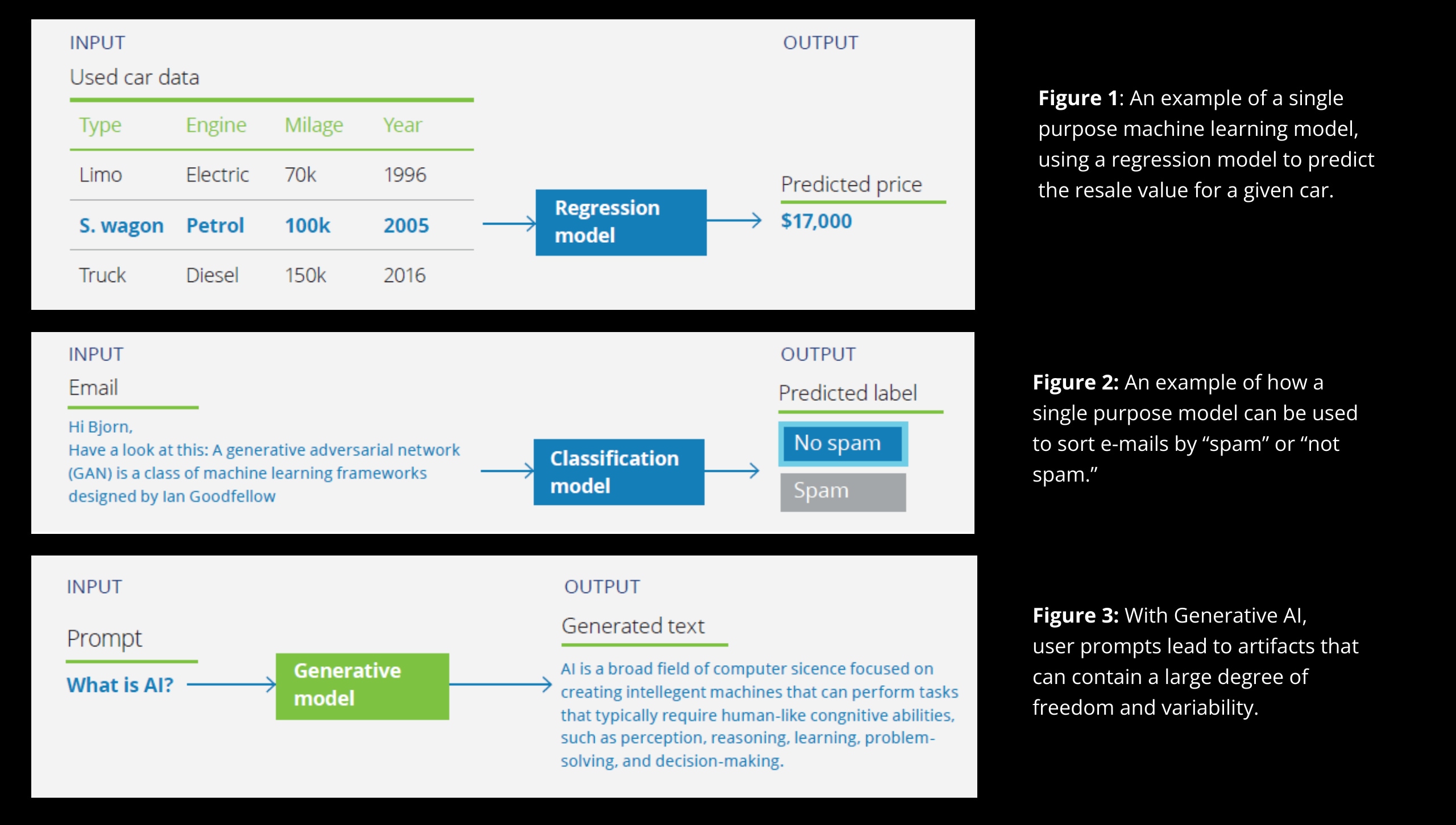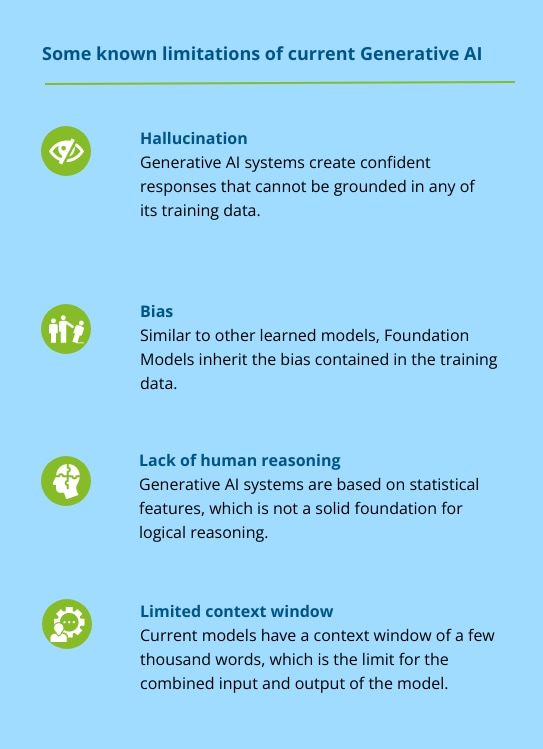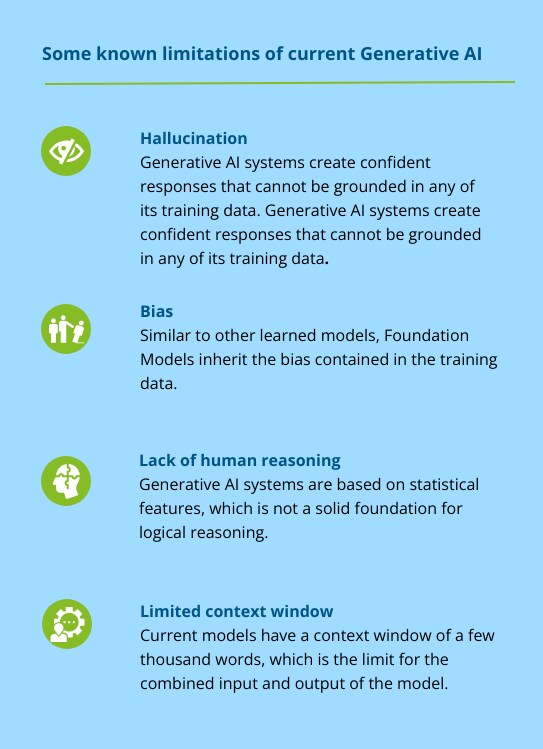Deloitte AI Institute
Benefits and limitations of Generative AI
How to extract enterprise value from Generative AI capabilities

Let’s take a moment to cut through the hype
Generative AI is all the rage
The AI field took a turn with the release of powerful Generative Artifical Intelligence (AI) models, and as a result, the world is seeing the automation of some skills around creativity and imagination sooner than many expected. For some organizations, Generative AI holds valuable potential for higher order opportunities, like new services and business models. Deloitte offers a method for selecting Generative AI use cases, as well as some next steps for business leaders in the Age of With™.
Generative AI has captured attention in global media and the public square, prompting questions and discussions around this transformative technology.
Businesses, research organizations, and even lay users are experimenting with Generative AI, and given the excitement and interest, it is important to look more closely at the potential capabilities and implications for business.
In this article, we examine the potential benefits and limitations of Generative AI, introduce a method to qualify if, where and how these cognitive tools could be used, and offer important factors for business leaders to weigh when adopting Generative AI.
Generative AI is a subset of artificial intelligence in which machines create new content in the form of text, code, voice, images, videos, processes, and even the 3D structure of proteins. Some forms of Generative AI have been well established in this decade, but it was a large language model (LLM) powering an easily accessible chat interface that enabled Generative AI to have its breakthrough moment and surprise even specialists in the field.
As with other types of AI before it, this new posterchild of AI is stimulating the imagination as organizations and individuals consider how to use this tool to benefit both business and society. Generative AI can help in incremental digitization and basic productivity use cases (e.g., more effective text-based channels). But its grander potential is in the higher order opportunities, such as new services or business models that were previously uneconomical.
Generative AI in general and LLM-powered chatbots in particular are not without risks, and this is prompting discussions around things like the potential for job losses and legal questions around intellectual property and ownership. What is more, because the chatbot mimics coherent human phrasing, it may give some the impression that the AI understands the prompts to which it responds, which can leads users to anthropomorphize the chatbot (i.e., the ELIZA effect, as seen in the work of computer scientist Joseph Weizenbaum).
- Deloitte is working on a variety of projects exploring the opportunities and business value Generative AI can create for our clients. From experiences and conversations thus far, the clear path ahead, as with all AI, is to attempt to discover and capitalize on capabilities while also responsibly managing the risks that are already emerging.


While this is still the beginning, it’s moving fast
Among organizations in all industries, there is interest in differentiating AI use cases, from public service applications to addressing climate change and transforming business functions (see Deloitte’s AI Dossier).
We have seen these kinds of automations emerge across a variety of areas and skillsets. The assumed roadmap for AI was that, in the shorter term, AI is most valuable as a way to automate operational skills, and creative skills will remain the exclusive province of human thinking for the foreseeable future. With Generative AI, this roadmap has taken an unexpected turn.
In late 2022, with the release of an easy-to-use Generative AI chatbot, more people began to discover and imagine how this new technology can be used in the creative space. The chatbot use case opened the door for thinking more broadly about how Generative AI can be used for tasks, ranging from writing copy to generating 3D structures and to outputting organizational processes. As such, we are now seeing the automation of some skills around creativity and imagination sooner than many expected.
- There is a lot left to discover. In this Age of With™, the era of humans working with intelligent machines to achieve things greater than what either could do alone, Generative AI will impact the future of work and become a common tool throughout various aspects of our daily lives. In some cases, the applications may be clearly visible, but more often than not, they may be working in the background.
How Generative AI works: Understanding the basics
To understand how Generative AI will impact business and life, we need to understand what it is, what it can do, and what it cannot do, yet.
In a process referred to as training, the algorithm is supplied with a large dataset of input/output examples to extract patterns from the input, which allow conclusions about the expected output. Spam filters, for example, use these patterns to identify similarities in data points and relate those to different classes (i.e., sorting email to a spam folder). While the input data has become more complex over time, from simple arrays of numbers to high-resolution photos, the output side of a model has to this point been mostly limited to categories like “spam” or “not spam,” “cat” or “dog,” or numerical values such as 7°C or $29. This approach powers nearly all AI that has been deployed so far, the result is “single purpose” applications that can only perform one task.
Generative AI models are typically large and resource hungry. Creating them requires terabytes of highquality data processed over weeks on large-scale, GPU-enabled, high performance computing clusters. Only a few institutions have the necessary resources and talent to build such models. Running a model also requires a lot of compute, which is why access to these kinds of models is often provided via an application programming interface (API). This allows developers to use the models with their existing software products without need for additional infrastructure. These models are versatile and can be fine-tuned for specific tasks, hence they are called Foundation Models. Unlike single-purpose AI, they are suited for multi-purpose tasks.

Regarding risks and rewards
Current Generative AI models have significant limitations. Perhaps the most well-known is termed “hallucination,” which refers to a high-confidence response that is not grounded in the training data. In other words, the response is fictional. For some applications, like art generation, this is a non-issue and perhaps even a desired “creative” feature of Generative AI. For other applications, however, such as copywriting or computer code generation, hallucinations can result in artifacts that are not entirely valid or true, which undercuts the potential value of Generative AI.
Another limiting factor is that today’s Generative AI models generate artifacts based on the model itself and the input prompt. Other additional sources and datasets cannot currently be integrated directly into the model’s internal information processing without costly re-training or fine-tuning, which means Generative AI models can only access information extracted from the data on which they were trained. For similar reasons, they cannot provide references and sources for the generated content, which complicates validation. Furthermore, current models have a context window of a few thousand words, which is the limit for the size of the combined input and output. However, Generative AI models can be combined with other systems (e.g., search, conversational AI) to leverage the benefits of both parts. For example, with a chatbot, a conversational AI system can serve as an orchestration layer between the Generative AI model, a search engine, and the user, which helps to amplify the user experience.
Similar to other AI models, Foundation Models can reproduce latent bias in the training data, and of course, they lack comprehension and the ability to reason as humans do. This has implications for the broader concept of Trustworthy AI™. After all, they are language models, image models, or voice models but not knowledge models. Despite limitations, Foundation Models can function at such a high quality that many new use cases become possible.


Generating revenue using Generative AI
Using this technology for business benefit can be conceived along two distinct approaches.
- In the first approach, the models can be used as they are available today, a simple interface that allows near-direct access to the underlying model in the form of a chat for text or an image generation tool.
- The second approach is to integrate Generative AI with other technologies to automate processes. For example, Generative AI can allow for human-level expressive interactions, while a conversational AI system (i.e., a chat- or voicebot) controls the flow and ensures factual accuracy. An example is an automated, Generative AI-powered call center. We expect the second approach will ultimately provide the most value.
Deloitte has designed a Digital Artifact Generation/Validation method to help innovation leaders determine whether an idea can be turned into a beneficial use case leveraging Generative AI. At the core of this method are two of the most critical elements to consider: the human effort required to complete a task without Generative AI; and the necessary effort to validate or fact check the output from the Generative AI. This leads to a two-dimensional classification, categorizing use cases based on the required human effort and the ability of the user to validate the results.
Reaping benefits from Generative AI requires more than identifying a good use case
Insights from Deloitte projects on Generative AI
Identifying use cases is only part of the challenge. Whenever a transformative technology emerges, some organizations are spurred to experiment for the sake of its novelty, which can lead to “random acts of digital” that do not deliver the anticipated return. Driving business results with Generative AI requires a strategy and collaboration from a cross-disciplinary team. In addition, with a technology that is advancing and maturing as quickly as Generative AI, avoid the temptation to go forward alone and instead find support and knowledge from partners, colleagues, and third-party organizations operating in this space.
The inherent complexity in current projects leveraging Generative AI requires a cross-disciplinary team to guide and govern the AI lifecycle. Professionals from a variety of domains can help the business answer critical questions, including:

Based on our observations and experience, we recommend business leaders avoid jumping head-first into the hype. Instead, we encourage decision makers to:
- Develop a strategy for Generative AI and integrate and harmonize it with the enterprise’s existing AI strategy. The same principles that guide an AI-fueled organization apply to the use of Generative AI (e.g., access to curated enterprise data; AI governance; process transformation to leverage cognitive workers, etc.). With a technology evolving this quickly, avoid the temptation to go forward alone. Find support and knowledge from partners and third-party organizations operating in this space.
- Become familiar with the underlying technologies that make Generative AI possible, as well as the current capabilities and limitations. Educate your workforce in the usage, risks, and capabilities of AI to establish a baseline of knowledge through training. Also monitor over time how the technology advances and the impact on business risks and opportunities, as they emerge.
- Bring together a cross-disciplinary team of people with the domain knowledge to think creatively about potential use cases. When business leaders, technology leaders, and creatives work together with external experts, they are able to identify valuable applications and also design Generative AI deployments, to mitigate business and cyber risks and meet applicable laws and regulations.
- Leverage Deloitte’s Digital Artifact Generation/Validation method to identify where Generative AI might impact your value chain, with incremental digitization from basic productivity use cases to higher order opportunities, such as new, differentiating services or business models.
- Ensure the collection and curation of proprietary data, as this is key for tailored use cases that provide a differentiator or competitive advantage.
- Assess use cases against Trustworthy AITM principles, including challenges around bias and misinformation, attribution, transparency, and enterprise accountability for the impact from Generative AI.
Deloitte is excited to move into the future with our clients and colleagues, as well as with our connections in academia and the broader AI ecosystem around the world.
The discussions so far show that there is a need for a deeper understanding of Generative AI, from the underlying technology to its impact on the future of work. As such, it is important to look closely at the implications for risk, trust, governance, which is investigated in a forthcoming article, “Proactive risk management in Generative AI.” There are also legal considerations for Generative AI, which we cover in “Legal implications of using Generative AI (What the AI System won’t tell you).”
- There is a lot to cover and the conversations are far from over. Deloitte is a trusted advisor as we push beyond the initial buzz around this new technology and into how Generative AI can be used for good in the Age of With™

Let's talk